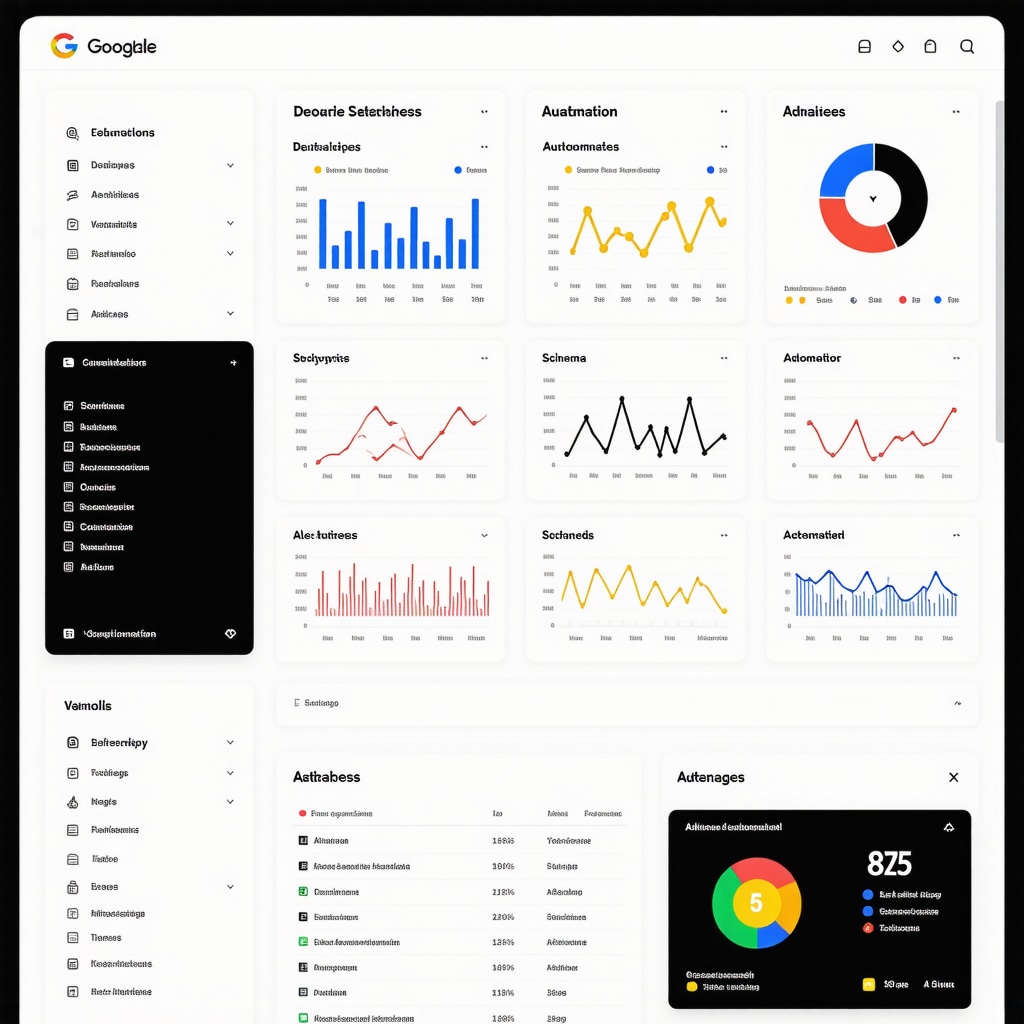Unlocking the Power of Google My Business SEO
Google My Business (GMB) has transformed from a simple business listing platform to a cornerstone of local search engine optimization (SEO). For local businesses aiming to maximize traffic, mastering GMB SEO best practices is no longer optional; it’s essential. But what truly sets apart a thriving GMB profile from a dormant one? The answer lies in sophisticated strategies that optimize visibility on Google Maps and local search results, tapping into the behaviors and expectations of nearby customers.
Crafting an Irresistible and Optimized GMB Profile
Your GMB listing is your digital storefront and first impression for local searchers. To leverage GMB SEO effectively, every detail must be meticulously optimized. This includes using precise business categories, crafting a compelling business description rich with relevant keywords, and regularly updating your profile with accurate hours and contact information. Integrating Latent Semantic Indexing (LSI) keywords related to your services and location enhances your listing’s topical relevance, helping Google better understand your business’s niche and thereby boosting your rankings.
For instance, a boutique bakery in Chicago should naturally include terms like “artisan bread Chicago,” “custom cakes Near Me,” and “local bakery specialties” within their description and posts. These nuanced keywords align with user search intent and improve the chances of appearing in the coveted local 3-pack.
Visual Storytelling: Elevate Engagement with Strategic Photo Optimization
Images are more than mere decoration; they act as powerful SEO signals and engagement drivers. Optimizing photos—by uploading high-quality images, naming files with targeted keywords, and regularly refreshing visuals—helps your profile stand out. Studies show that GMB profiles with attractive, keyword-optimized photos receive significantly higher engagement and click-through rates. Photos also contribute to your business’s authenticity and trustworthiness, factors Google increasingly prioritizes.
How Can Consistent Review Management Boost Your GMB SEO?
Customer reviews are a critical pillar of GMB SEO. Beyond influencing consumer trust, reviews impact your local search rankings. Encouraging authentic, detailed reviews and promptly responding to feedback signals to Google that your business is active and customer-focused. Implementing a structured review generation strategy—such as following up post-service with personalized review requests—can dramatically increase review volume and quality. This not only enhances your SEO but also builds social proof that converts casual browsers into loyal customers.
Harnessing GMB Posts and Q&A for Dynamic Local SEO
Google My Business posts and the Q&A section offer dynamic content opportunities often overlooked by many businesses. Publishing regular posts with promotions, events, or updates embeds fresh content that Google loves. Similarly, proactively managing the Q&A by answering common customer inquiries with keyword-rich, helpful responses improves your profile’s relevance and user experience. This strategic content layering can significantly amplify your local search presence.
For those seeking an in-depth roadmap, the complete guide to mastering Google Business SEO offers comprehensive insights and actionable tactics to elevate your GMB profile’s performance.
Integrating Authoritative Citations and Local Backlinks
Beyond on-profile optimization, building authoritative local citations and backlinks strengthens your GMB SEO foundation. Citations from reputable local directories, chambers of commerce, and industry-specific platforms enhance your business’s credibility and trustworthiness in Google’s eyes. Consistency in your Name, Address, and Phone Number (NAP) across these citations is crucial to avoid confusion and penalties.
Moreover, cultivating backlinks from local blogs, news outlets, and partners integrates your profile into the broader local ecosystem, signaling relevance and authority. This holistic approach to GMB SEO can dramatically accelerate your rankings and traffic.
Engage with Your Audience: A Call to Action for Local Business Owners
Have you implemented these GMB SEO best practices yet? Share your experiences or questions in the comments below to join a community of local business owners mastering Google Business SEO for unparalleled traffic growth. For further expert techniques, explore our detailed strategies on effective GMB ranking strategies.
Reference: According to Moz’s Local SEO Guide, optimizing your Google My Business profile with comprehensive information and regular updates significantly improves local search rankings and customer engagement (Moz Local SEO).
Understanding the Nuances of Google My Business Ranking Factors
While basic GMB optimization sets the foundation, diving deeper into the ranking factors reveals how user behavior and local signals intricately influence your profile’s positioning. Metrics such as click-through rates on your profile, direction requests, and even the frequency of calls generated through GMB are subtle yet powerful signals to Google’s algorithm that your business is highly relevant to local searchers.
To capitalize on this, businesses should not only optimize for keyword relevance but also encourage interactions that Google can track. For example, adding clear calls to action on your GMB posts or photos can entice users to engage more actively, boosting your profile’s behavioral metrics.
How Can Tracking User Interaction Data Enhance Your GMB SEO Strategy?
Analyzing performance insights available within your GMB dashboard offers vital clues into user behavior patterns. By understanding which queries trigger your listing, how users find your profile, and what actions they take, you can tailor your content and engagement tactics to align better with search intent. For instance, if you notice a high volume of “near me” searches, emphasizing hyperlocal keywords and location-based content will further amplify your visibility.
Moreover, responding to user questions in the Q&A section and monitoring review sentiments can guide your service offerings and marketing messages. This data-driven approach ensures your GMB profile remains dynamic and responsive, fostering higher engagement and improved rankings.
Local Schema Markup: Bridging Your Website and GMB for Enhanced SEO
Integrating local business schema markup on your website complements your GMB SEO efforts by providing structured data that helps search engines better interpret your business information. Schema markup enhances your chances of appearing in rich snippets and local packs, which increases clickability and trust.
Ensure that your website’s NAP details match exactly with your GMB listing, and use schema to mark up key elements such as your address, phone number, business hours, and customer reviews. This alignment reinforces your business’s credibility and authority in local search results.
For those looking to deepen their technical SEO skills, our local search engine optimization hacks for Google Business guide offers practical steps to implement schema markup effectively.
Strategic Use of Google My Business Attributes and Services
Google My Business attributes allow you to highlight specific features or offerings, such as “wheelchair accessible,” “women-led,” or “free Wi-Fi.” These attributes not only help your listing stand out but also cater to niche audience segments, increasing relevance and user satisfaction.
Additionally, accurately listing your services with detailed descriptions and pricing can capture long-tail searches and improve conversion rates. For instance, a local spa might list services like “deep tissue massage Chicago” or “organic facial treatments near me” to attract highly targeted traffic.
Leveraging Video Content in Your Google My Business Profile
Video is an increasingly influential form of content in local SEO. Uploading short, high-quality videos showcasing your products, services, or customer testimonials can significantly enhance user engagement. Videos often keep visitors on your profile longer, sending positive behavioral signals to Google.
Videos should be optimized with descriptive titles and relevant keywords in their descriptions. Regularly updating your video content ensures your profile remains fresh and appealing.
Explore more advanced multimedia optimization strategies in our resource on optimizing your GMB listing to dominate local search.
What Are the Emerging Trends in GMB SEO That Experts Should Prepare For?
As Google continuously updates its local search algorithms, staying ahead requires an adaptive approach. Emerging trends include increased integration of AI-driven personalization, voice search optimization, and the use of Google Business Profiles for service-area businesses with no physical storefront.
Experts must also consider the rise of hyperlocal targeting, where micro-moment marketing and geofencing can create highly tailored user experiences. Additionally, the growing importance of Google Maps features like booking integrations and messaging directly from the profile will reshape how local businesses interact with customers.
Staying informed on these trends and incorporating innovative tactics will secure your competitive edge in the evolving local SEO landscape.
For an expert perspective and tactical updates, visit Moz’s authoritative resource on Local SEO, which is widely respected for its data-driven insights and industry best practices.
Take Your GMB SEO to the Next Level
Have you experimented with advanced GMB features like video uploads or schema markup? Share your experiences or questions in the comments to foster a knowledge-sharing community of local SEO experts. Also, consider exploring our detailed effective GMB ranking strategies for actionable ways to elevate your Google Business Profile performance and dominate your local market.
Behavioral Metrics: The Hidden Drivers Behind Your GMB Ranking
While keyword optimization remains foundational, the nuanced interpretation of user behavioral metrics by Google’s algorithm increasingly dictates your Google My Business (GMB) ranking trajectory. Key indicators such as click-through rates (CTR), direction requests, phone call frequency, and even the duration visitors spend on your profile signal the level of engagement and relevance your business holds for local searchers.
For example, a surge in direction requests from mobile devices not only demonstrates immediate intent but also boosts your profile’s local prominence. Encouraging interactions through strategic CTAs—like “Call Now,” “Get Directions,” or “Book Appointment”—in your GMB posts or descriptions can significantly elevate these engagement metrics, sending strong positive signals to Google’s local ranking algorithm.
How Can Behavioral Data Integration Refine Local SEO Tactics?
Integrating behavioral data into your SEO strategy enables a data-driven approach to GMB optimization. By meticulously analyzing the Insights dashboard within GMB, businesses can discern patterns in how customers discover and interact with their profile. For instance, if “near me” searches predominate, intensifying hyperlocal keyword usage and tailoring service descriptions to specific neighborhoods or landmarks can enhance relevance.
Moreover, tracking fluctuations in user actions over time helps identify content or offerings that resonate best, informing iterative refinements to your profile. This dynamic feedback loop not only improves rankings but also augments customer experience by aligning your digital presence with actual user intent.
Local Schema Markup: Structuring Data for Enhanced Search Engine Interpretation
Local schema markup is a sophisticated SEO tactic that structures your website’s data to communicate explicitly with search engines. Implementing Schema.org LocalBusiness markup on your site ensures that Google accurately parses critical business information—such as your address, operating hours, contact details, and customer reviews—thereby enhancing your eligibility for rich snippets and local pack inclusion.
Crucially, schema markup must be kept consistent with your GMB profile data to avoid conflicting signals. Use JSON-LD format for implementation, as it is the preferred method by Google for ease of parsing and minimal website disruption. Employing tools like Google’s Rich Results Test can validate your markup’s correctness and effectiveness.
What Are the Best Practices for Maintaining Schema Consistency Across Platforms?
Maintaining NAP (Name, Address, Phone number) consistency across your GMB profile, website schema markup, and external citations is paramount for local SEO success. Discrepancies can confuse search engines, undermining trust and potentially harming rankings.
Automated auditing tools such as Moz Local or BrightLocal can streamline the identification of inconsistencies across directories and profiles. Regularly scheduled audits, coupled with prompt corrections, help maintain a unified digital footprint. Additionally, documenting your core business information in a centralized repository ensures accuracy across marketing teams and platforms.
Integrating Behavioral Metrics and Schema Markup: A Synergistic Approach
Combining behavioral data insights with robust schema markup creates a powerful synergy that elevates your local search dominance. While schema markup structurally enhances your business information’s clarity to search engines, behavioral engagement metrics validate your business’s relevance and appeal to users.
This dual approach not only boosts your visibility but also enriches user experience, fostering higher conversion rates. Businesses that adeptly integrate these advanced strategies position themselves as authoritative and trustworthy in their local markets.
For a deeper dive into leveraging behavioral analytics alongside structured data for Google My Business success, explore the comprehensive resources available at Moz Local SEO Guide, renowned for its expert-backed insights and actionable frameworks.
Embracing Emerging Technologies: The Future of GMB SEO
Looking ahead, emerging technologies like Artificial Intelligence (AI) and Machine Learning (ML) are poised to transform GMB SEO. AI-powered chatbots integrated via Google Business Messages will facilitate real-time customer interactions directly from your profile, enhancing engagement and behavioral signals.
Furthermore, voice search optimization is becoming increasingly critical as consumer habits shift towards hands-free queries. Optimizing your GMB content to align with natural language processing and conversational keywords will future-proof your local SEO efforts.
Implementing geofencing and hyperlocal targeting strategies using location data analytics can also personalize customer outreach, enhancing both online and offline conversions.
Stay tuned for our upcoming expert series that will delve into harnessing these cutting-edge technologies to maintain a competitive advantage in the evolving landscape of Google My Business SEO.
Join the Expert Conversation and Elevate Your GMB Strategy
Are you leveraging behavioral metrics and schema markup to their fullest potential? Share your insights, challenges, or questions in the comments to participate in an advanced discourse with fellow local SEO professionals. For actionable, expert-level tactics, visit our detailed guide on effective GMB ranking strategies that will help you dominate your local market with precision.
Decoding Behavioral Analytics for Precision GMB Optimization
Leveraging behavioral analytics transcends traditional keyword optimization by unveiling granular user engagement patterns within your Google My Business profile. By dissecting metrics such as click-through rates segmented by device type, dwell time on specific content sections, and conversion pathways originating from GMB interactions, businesses can architect hyper-targeted optimization strategies. These insights enable anticipatory adjustments—like tailoring post timings to peak engagement windows or refining call-to-action phrasing based on user responsiveness—thereby maximizing the efficacy of your local SEO efforts.
How Can Advanced Behavioral Segmentation Enhance GMB Performance?
Advanced segmentation involves categorizing user interactions by parameters such as demographics, search intent, and device usage. For instance, identifying that mobile users predominantly seek “near me” services during commute hours allows businesses to schedule timely promotions and optimize service descriptions accordingly. Integrating tools like Google Analytics alongside GMB Insights facilitates this multidimensional analysis, empowering businesses to curate highly personalized local marketing campaigns that resonate with distinct audience segments.
Elevating Local SEO with Enhanced Schema Strategies
Beyond basic LocalBusiness schema implementation, adopting rich schema types such as Service, Offer, and Review schemas can exponentially enrich your profile’s search engine comprehension. These structured data types encapsulate nuanced information—like service-specific pricing, available discounts, and detailed customer feedback—that Google leverages to generate compelling rich snippets and knowledge panel enhancements.
Moreover, embedding GeoCoordinates within your schema markup refines geospatial accuracy, which is pivotal for hyperlocal search relevancy. Employing JSON-LD format ensures seamless integration and future-proofing against evolving search engine parsing algorithms.
For a methodical schema deployment roadmap, refer to Google’s official guidelines on structured data (Google Structured Data for Local Business).
Strategic Synergies: Merging Behavioral Insights with Schema Markup
Marrying behavioral analytics with sophisticated schema markup creates a feedback-driven optimization loop. Behavioral data illuminates which services or attributes resonate most with users, guiding schema enhancements to highlight these elements prominently. Conversely, robust schema markup amplifies the visibility of well-performing services in search results, catalyzing further user engagement.
This synergistic approach not only fortifies your GMB profile’s authority but also cultivates a dynamic, user-centric local SEO ecosystem that adapts responsively to market shifts and consumer preferences.

Expert Perspectives on Leveraging AI and Automation in GMB SEO
Artificial Intelligence and automation tools are revolutionizing GMB management by streamlining repetitive tasks such as review solicitation, response generation, and post scheduling. AI-driven sentiment analysis helps prioritize customer feedback, enabling businesses to address critical issues swiftly and enhance reputation management.
Additionally, machine learning models can predict optimal keyword insertions and attribute updates based on evolving search trends, ensuring your GMB profile remains at the forefront of local search algorithms.
What Are the Best AI-Powered Tools to Optimize GMB Profiles Effectively?
Tools like BrightLocal and Moz Local incorporate AI features to automate review management, citation monitoring, and performance reporting. Utilizing these platforms not only reduces manual workload but also provides actionable insights derived from large datasets, empowering businesses to make informed, strategic decisions.
Engage and Elevate: Join the Advanced GMB SEO Dialogue
Are you harnessing behavioral analytics, enriched schema markup, and AI automation in your local SEO strategy? Share your experiences or pose complex queries in the comments to connect with industry experts and elevate your Google My Business mastery. For further in-depth analyses and cutting-edge tactics, explore our comprehensive effective GMB ranking strategies guide.
Frequently Asked Questions (FAQ)
What is the importance of behavioral metrics in Google My Business SEO?
Behavioral metrics such as click-through rates, direction requests, phone calls, and time spent on your GMB profile are vital indicators of user engagement. Google’s algorithm interprets higher engagement as a sign of relevance and authority, which can significantly improve your local ranking. Encouraging interactions via clear calls to action helps boost these key metrics.
How does schema markup enhance my local SEO alongside Google My Business?
Schema markup provides structured data that helps search engines accurately interpret your business information, such as NAP details, services, and reviews. Implementing LocalBusiness schema and rich schema types like Service and Review improves eligibility for rich snippets and local pack features, increasing your visibility and clickability in search results.
How can I maintain consistency across my GMB profile, website, and citations?
Maintaining Name, Address, and Phone number (NAP) consistency is crucial. Use tools like Moz Local or BrightLocal for automated audits to identify discrepancies. Regularly verify and update your information across all platforms to build trust with search engines and avoid ranking penalties.
What role does AI and automation play in optimizing Google My Business profiles?
AI-powered tools streamline tasks such as review solicitation, sentiment analysis, response generation, and post scheduling. They help prioritize customer feedback and optimize keyword insertion based on search trends, enabling businesses to maintain a competitive edge with less manual effort.
Can video content improve my GMB SEO, and how should I optimize it?
Yes, video content increases engagement by keeping visitors on your profile longer and providing rich user experience. Optimize videos with descriptive titles and keyword-rich descriptions, and upload regularly to keep your profile fresh and appealing.
What emerging trends should local businesses prepare for in Google My Business SEO?
Emerging trends include AI-driven personalization, voice search optimization, hyperlocal targeting with geofencing, and enhanced Google Maps features like booking and messaging. Adapting to these trends early will help maintain relevance and capitalize on new customer interaction channels.
How can I leverage the Q&A section effectively on my GMB profile?
Proactively answering common or strategic questions with keyword-rich, helpful responses enhances your profile’s relevance and user experience. Monitoring and managing this section ensures accurate information and prevents misinformation that could deter potential customers.
What are the best practices for optimizing photos on Google My Business?
Upload high-quality images named with targeted keywords, refresh visuals regularly, and showcase your products, services, and ambiance. Optimized photos boost engagement and signal authenticity and trustworthiness to Google.
How does integrating behavioral analytics refine local SEO strategies?
Behavioral analytics reveal detailed user interaction patterns, enabling tailored content and service descriptions that align with user intent. This data-driven approach improves rankings by focusing on what resonates most with your audience.
How can local citations and backlinks influence GMB SEO?
Authoritative local citations and backlinks from reputable sources enhance your business’s credibility and authority in Google’s eyes. Consistent NAP information across these citations reinforces trust and can significantly boost your local search rankings.
Trusted External Sources
- Moz Local SEO Guide: Provides comprehensive, data-driven insights into local SEO best practices, including GMB optimization, behavioral metrics, and schema markup strategies.
- Google Developers – Structured Data for Local Business: Offers official guidelines and technical specifications for implementing schema markup effectively to enhance search engine understanding.
- BrightLocal: A leading platform for local SEO tools, including citation management, review monitoring, and AI-driven analytics to optimize GMB profiles.
- Google My Business Help Center: The authoritative resource for updates on GMB features, policies, and optimization tips directly from Google.
- Search Engine Journal – Local SEO Section: Features expert articles, emerging trends analysis, and advanced tactics for mastering Google Business SEO.
Conclusion
Mastering Google My Business SEO today demands a multifaceted approach that balances foundational optimizations with advanced strategies. Behavioral metrics provide invaluable feedback loops that reflect genuine user engagement, while schema markup structurally empowers search engines to accurately interpret your business information. The integration of AI and automation further streamlines management, enabling proactive and data-driven adaptations to evolving local search dynamics.
By consistently maintaining precise business information, leveraging rich multimedia content, and embracing emerging technologies, local businesses can secure a commanding presence in Google’s local search ecosystem. This holistic mastery not only elevates visibility but also cultivates trust and drives meaningful customer interactions.
Ready to elevate your Google My Business profile to new heights? Share your insights, ask questions, and explore our expert guides to unlock the full potential of your local SEO strategy. Your journey to local dominance starts now.



